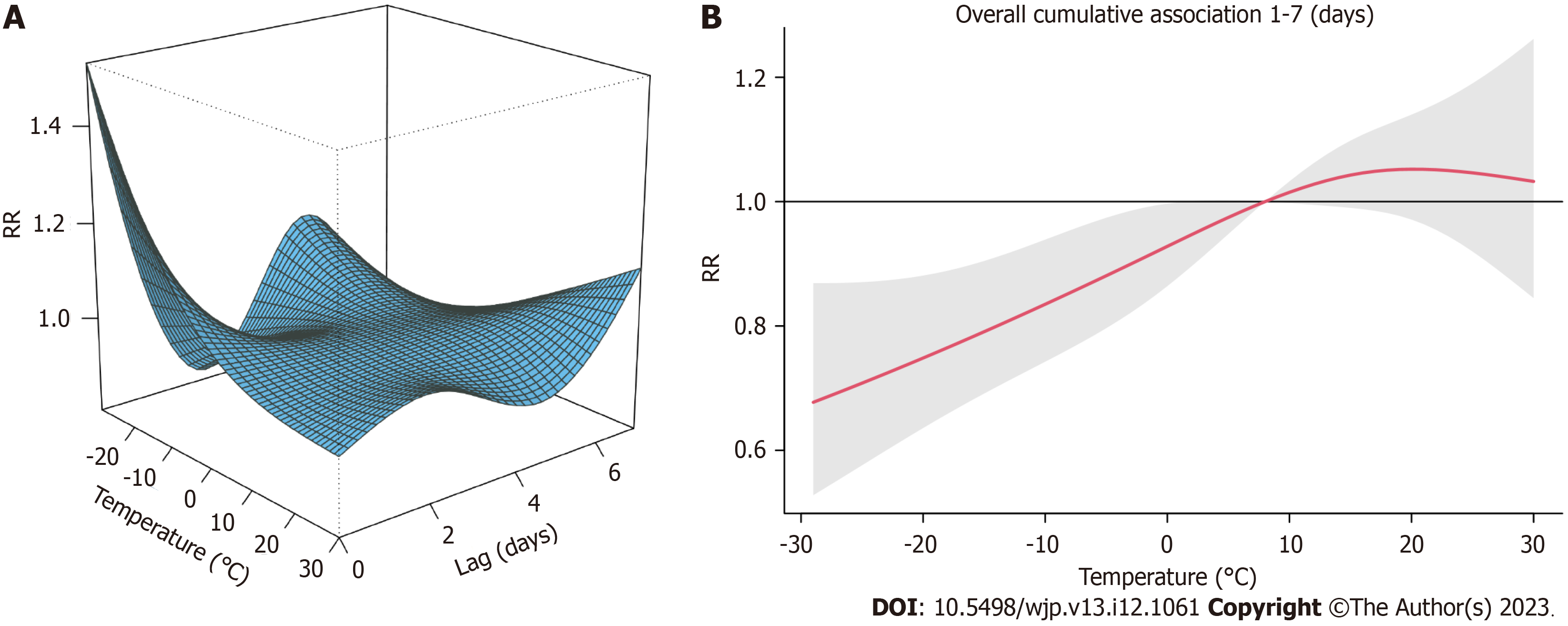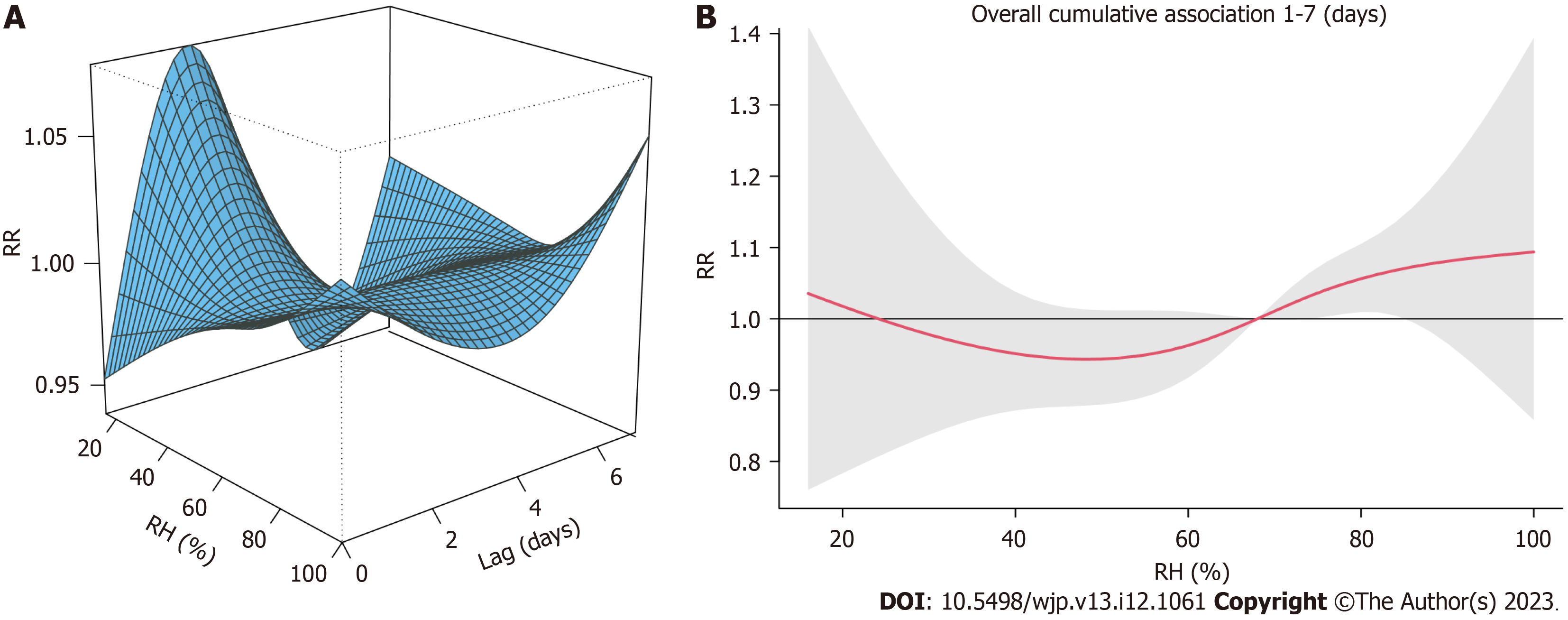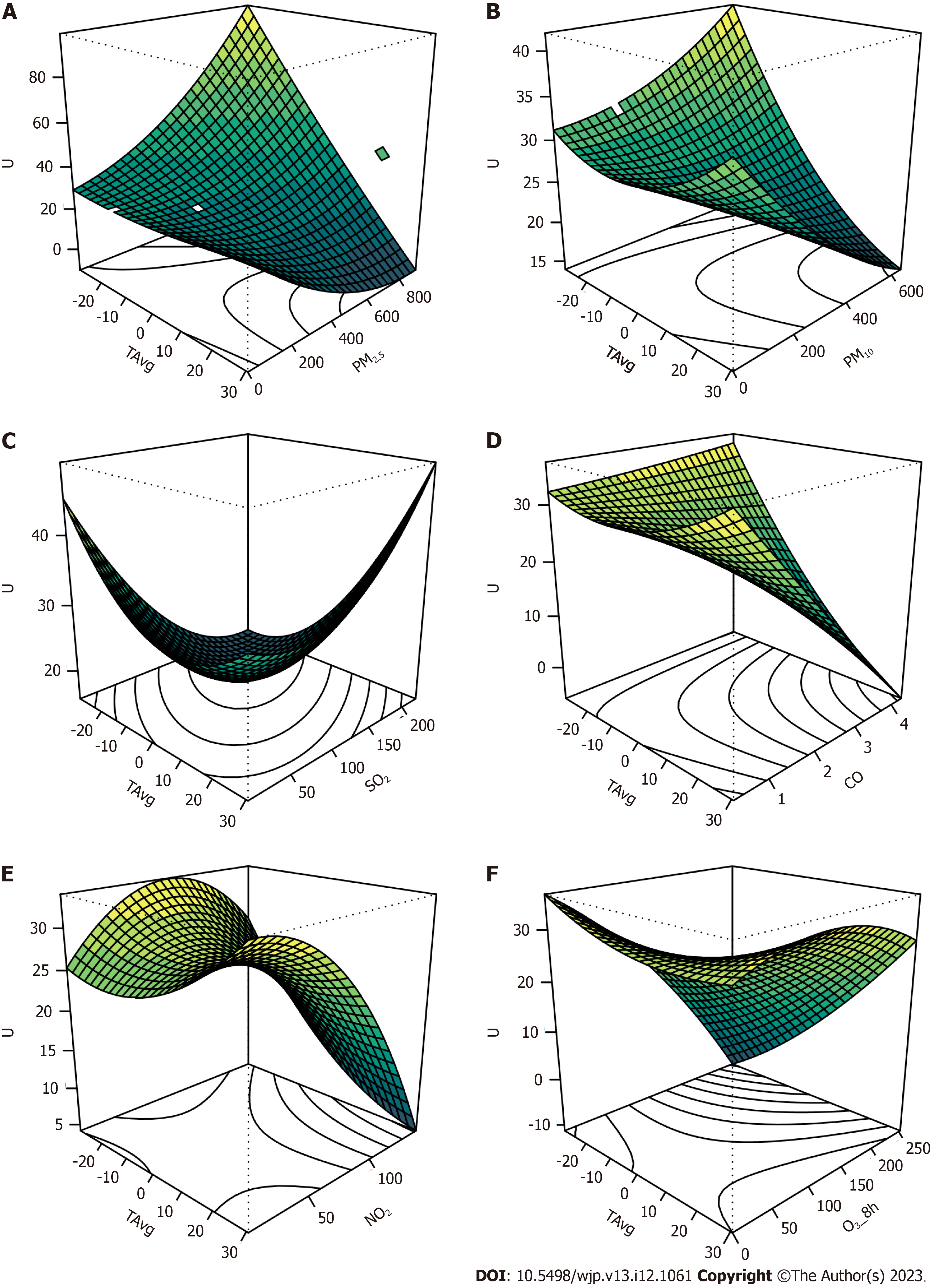Copyright
©The Author(s) 2023.
World J Psychiatry. Dec 19, 2023; 13(12): 1061-1078
Published online Dec 19, 2023. doi: 10.5498/wjp.v13.i12.1061
Published online Dec 19, 2023. doi: 10.5498/wjp.v13.i12.1061
Figure 1 Effects of air temperature on hospital admissions for depressive disorder.
A: 3D plot of relative risk (RR) along air temperature and lags, with reference to the median temperature of 7.8 ℃; B: Overall RR of lags 1-7 by air temperature, with reference at 7.8 ℃. RR: Relative risk.
Figure 2 Effects of atmospheric pressure on hospital admissions for depressive disorder.
A: 3D plot of relative risk (RR) along atmospheric pressure (AP) and lags, with reference to the median AP of 748.9 mmHg; B: Overall RR of lags 1-7 by atmospheric pressure, with reference at 748.9 mmHg. RR: Relative risk; AP: Atmospheric pressure.
Figure 3 Effects of wind speed on hospital admissions for depressive disorder.
A: 3D plot of relative risk (RR) along wind speed (WS) and lags, with reference to the median WS of 2.6 m/s; B: Overall RR of lags 1-7 by wind speed, with reference at 2.6 m/s. RR: Relative risk; WS: Wind speed.
Figure 4 Effects of relative humidity on hospital admissions for depressive disorder.
A: 3D plot of relative risk (RR) along relative humidity (RH) and lags, with reference to the median RH of 67.9%; B: Overall RR of lags 1-7 by RH, with reference at 67.9%. RR: Relative risk; RH: Relative humidity.
Figure 5 Plots of relative risk by air temperature at lags 0-7.
A: Relative risk (RR) by air temperature (AT) at lag 0; B: RR by AT at lag 1; C: RR by AT at lag 2; D: RR by AT at lag 3; E: RR by AT at lag 4; F: RR by AT at lag 5; G: RR by AT at lag 6; H: RR by AT at lag 7. Reference at 7.8 ℃. RR: Relative risk.
Figure 6 Plots of relative risk by atmospheric pressure at lags 0-7.
A: Relative risk (RR) by atmospheric pressure (AP) at lag 0; B: RR by AP at lag 1; C: RR by AP at lag 2; D: RR by AP at lag 3; E: RR by AP at lag 4; F: RR by AP at lag 5; G: RR by AP at lag 6; H: RR by AP at lag 7. Reference at 748.9 mmHg. RR: Relative risk. AP: Atmospheric pressure.
Figure 7 Plots of relative risk by wind speed at lags 0-7.
A: Relative risk (RR) by wind speed (WS) at lag 0; B: RR by WS at lag 1; C: RR by WS at lag 2; D: RR by WS at lag 3; E: RR by WS at lag 4; F: RR by WS at lag 5; G: RR by WS at lag 6; H: RR by WS at lag 7. Reference at 2.6 m/s. RR: Relative risk; WS: Wind speed.
Figure 8 Plots of relative risk by relative humidity at lags 0-7.
A: Relative risk (RR) by relative humidity (RH) at lag 0; B: RR by RH at lag 1; C: RR by RH at lag 2; D: RR by RH at lag 3; E: RR by RH at lag 4; F: RR by RH at lag 5; G: RR by RH at lag 6; H: RR by RH at lag 7. Reference at 67.9%. RR: Relative risk; RH: Relative humidity.
Figure 9 Plots of relative risk by air pollutant concentrations at lags 0-7.
A: Relative risk (RR) by fine particles concentrations at lags 0-7; B: RR by inhalable particles concentrations at lags 0-7; C: RR by sulfur dioxide2 concentrations at lags 0-7; D: RR by carbon monoxide concentrations at lags 0-7; E: RR by nitrogen dioxide concentrations at lags 0-7; F: RR by maximum 8-h average concentration of ozone concentrations at lags 0-7. PM2.5: Fine particles; PM10: Inhalable particles; SO2: Sulfur dioxide; CO: Carbon monoxide; NO2: Nitrogen dioxide; O3_8h: Maximum 8-h average concentration of ozone; RR: Relative risk.
Figure 10 Plots of relative risk by cumulative air pollutant concentrations for lags 0-7.
A: Relative risk (RR) by cumulative fine particles concentrations at lags 0-7; B: RR by cumulative inhalable particles concentrations at lags 0-7; C: RR by cumulative sulfur dioxide concentrations at lags 0-7; D: RR by cumulative carbon monoxide concentrations at lags 0-7; E: RR by cumulative nitrogen dioxide concentrations at lags 0-7; F: RR by cumulative maximum 8-h average concentration of ozone concentrations at lags 0-7. PM2.5: Fine particles; PM10: Inhalable particles; SO2: Sulfur dioxide; CO: Carbon monoxide; NO2: Nitrogen dioxide; O3_8h: Maximum 8-h average concentration of ozone; RR: Relative risk.
Figure 11 3D perspective plots of the interaction effects between air temperature and air pollutants on daily hospital admissions for depressive disorder.
A: Interaction between air temperature (AT) and fine particles; B: Interaction between AT and inhalable particles; C: Interaction between AT and sulfur dioxide; D: Interaction between AT and carbon monoxide; E: Interaction between AT and nitrogen dioxide; F: Interaction between AT and maximum 8-h average concentration of ozone. AT: Air temperature; PM2.5: Fine particles; PM10: Inhalable particles; SO2: Sulfur dioxide; CO: Carbon monoxide; NO2: Nitrogen dioxide; O3_8h: Maximum 8-h average concentration of ozone.
Figure 12 3D perspective plots of the interaction effects between atmospheric pressure and air pollutants on daily hospital admissions for depressive disorder.
A: Interaction between atmospheric pressure (AP) and fine particles; B: Interaction between AP and inhalable particles; C: Interaction between AP and sulfur dioxide; D: Interaction between AP and carbon monoxide; E: Interaction between AP and nitrogen dioxide; F: Interaction between AP and maximum 8-h average concentration of ozone. AP: Atmospheric pressure; PM2.5: Fine particles; PM10: Inhalable particles; SO2: Sulfur dioxide; CO: Carbon monoxide; NO2: Nitrogen dioxide; O3_8h: Maximum 8-h average concentration of ozone.
Figure 13 3D perspective plots of the interaction effects between wind speed and air pollutants on daily hospital admissions for depressive disorder.
A: Interaction between wind speed (WS) and fine particles; B: Interaction between WS and inhalable particles; C: Interaction between WS and sulfur dioxide; D: Interaction between WS and carbon monoxide; E: Interaction between WS and nitrogen dioxide; F: Interaction between WS and maximum 8-h average concentration of ozone. WS: Wind speed; PM2.5: Fine particles; PM10: Inhalable particles; SO2: Sulfur dioxide; CO: Carbon monoxide; NO2: Nitrogen dioxide; O3_8h: Maximum 8-h average concentration of ozone.
Figure 14 3D perspective plots of the interaction effects between relative humidity and air pollutants on daily hospital admissions for depressive disorder.
A: Interaction between relative humidity (RH) and fine particles; B: Interaction between RH and inhalable particles; C: Interaction between RH and sulfur dioxide; D: Interaction between RH and carbon monoxide; E: Interaction between RH and nitrogen dioxide; F: Interaction between RH and maximum 8-h average concentration of ozone. RH: Relative humidity; PM2.5: Fine particles; PM10: Inhalable particles; SO2: Sulfur dioxide; CO: Carbon monoxide; NO2: Nitrogen dioxide; O3_8h: Maximum 8-h average concentration of ozone.
- Citation: Hu T, Xu ZY, Wang J, Su Y, Guo BB. Meteorological factors, ambient air pollution, and daily hospital admissions for depressive disorder in Harbin: A time-series study. World J Psychiatry 2023; 13(12): 1061-1078
- URL: https://www.wjgnet.com/2220-3206/full/v13/i12/1061.htm
- DOI: https://dx.doi.org/10.5498/wjp.v13.i12.1061






















